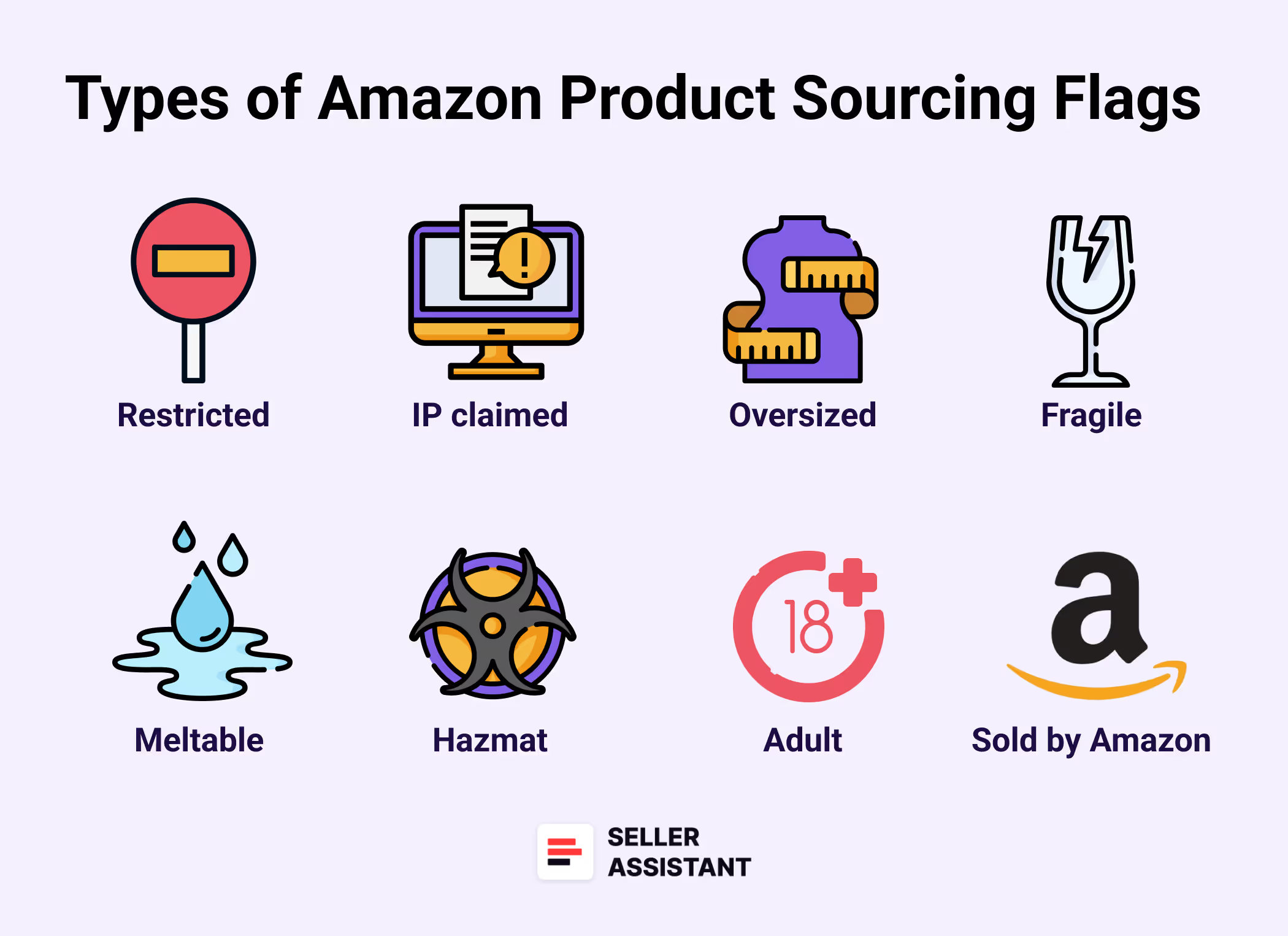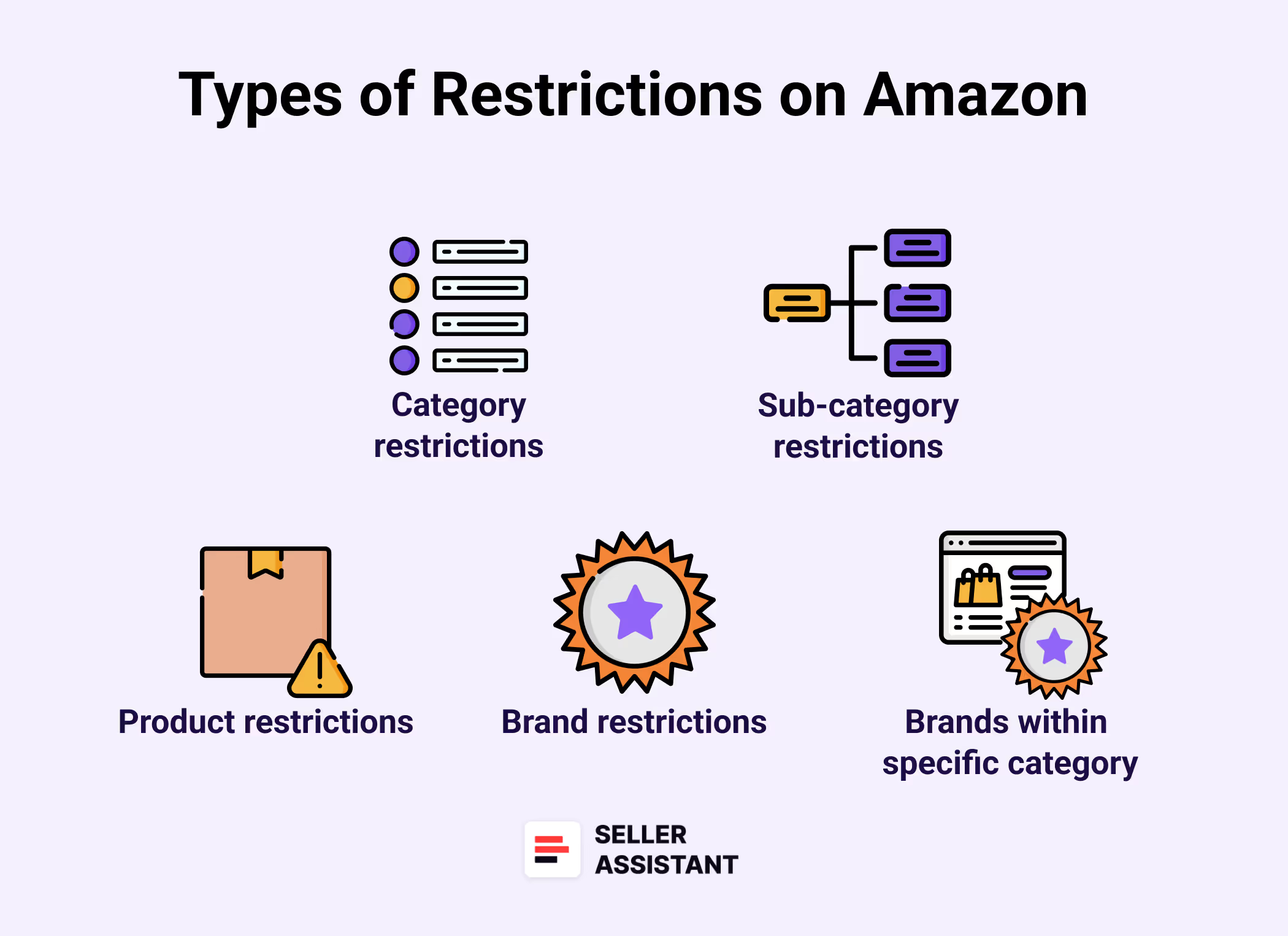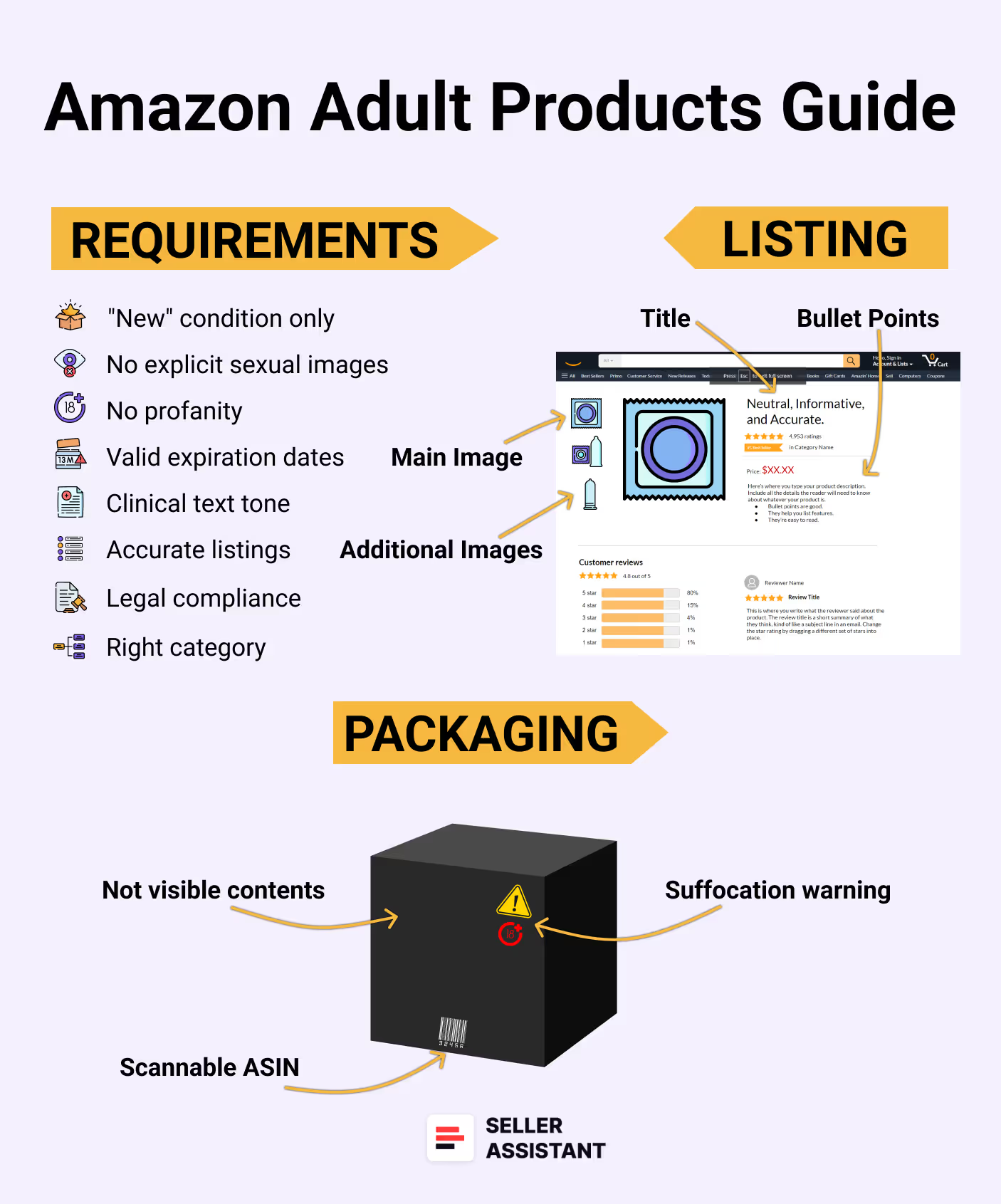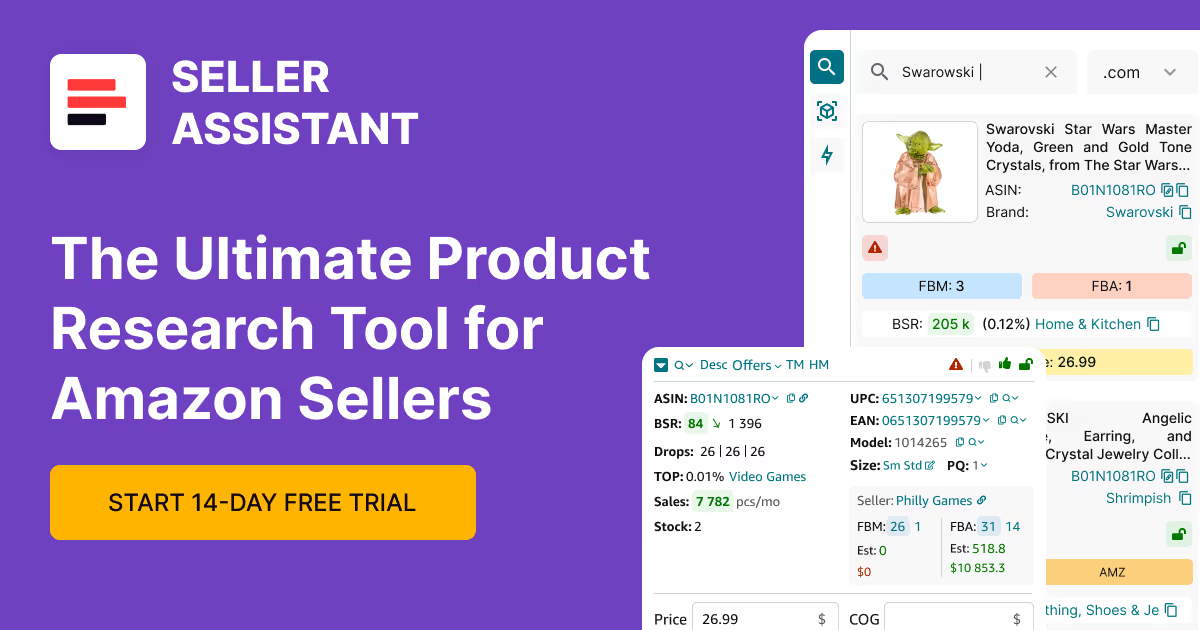What Products to Avoid Selling on Amazon?
Download Amazon Seller Guide
This guide will help you get started, understand the basics of Amazon selling, and explain in simple words how it all works.

As an Amazon seller, finding profitable products to sell is a challenging task. Not only must they meet certain criteria, such as high profit margin, high demand, and low competition. The items worth investing in must not create problems when you sell them.
If you sell a problematic product, that can cost you extra money or even a deactivated listing. To avoid that, you must verify inventory for Amazon product sourcing flags.
In this post, we'll take a closer look at product sourcing flags, and how they work, and give you a tip on how to quickly identify problematic products.
What Are Amazon Product Sourcing Flags?
Amazon product sourcing flags are alerts prompting that a product can create problems when you sell it on Amazon. They are indicators of potential challenges or dealbreakers.
When you do product research, you can come across profitable products with very low competition. However, often that means a product has intellectual property complaints from the brand owner, or has sales limitations. For example, it can be meltable or oversize, which incurs extra costs. That means, a product has sourcing flags.
Understanding product sourcing flags is crucial to identifying and avoiding risky deals. They allow sellers to make informed decisions about the products worth investment and the ones not suitable for selling.
Types of Amazon Product Sourcing Flags
Different types of product sourcing flags indicate the kind of problem with the item. Some of the product sourcing flags like product restrictions, fragile or adult products, simply mean extra hassle and cost selling them. If you go for selling such items, product sourcing flags help identify potential challenges.
Other flags are dealbreakers, like products with IP complaints. That is because selling such products means violating intellectual property rights.

Related: Seller Assistant Extension Review
Seller Assistant — the Ultimate Tool for Amazon Online Arbitrage
Restricted products
Restricted products can be listed only after getting permission from Amazon. Products may be restricted because of safety requirements, licensing, and certification, limited distribution, or quality assurance.
Examples. Some products are controlled for legal reasons or safety concerns, like alcohol or fireworks. Others demand high standards and verification, like fine art or cosmetics.

Related: Amazon Restricted Products – Complete Guide for Sellers
How to Check Product Restrictions on Amazon?
Why avoid sourcing restricted products?
Getting approval from Amazon to sell a restricted product (ungating) involves extra time and effort. Ungating typically requires submitting additional documents like invoices, manufacturer certifications, warranties, etc. In some cases that means some fees as well.
Selling unapproved restricted products will create serious problems. Amazon can deactivate your offers and ban your account if the violation repeats.
.avif)
Related: How To Get Ungated On Amazon
Products with IP complaints
Amazon Intellectual Property (IP) complaints are claims from the rights owners who believe their intellectual property rights, such as trademarks, copyrights, or patents, are infringed.
On Amazon, the scope of IP complaints is much wider. It includes eight types of violations and complaints, often filed not only by the brand owners but also by the customers.
Types of Amazon IP complaints
- Suspected Intellectual Property Violation;
- Received Intellectual Property Complaints;
- Product Authenticity Customer Complaints;
- Product Condition Customer Complaints;
- Food and Product Safety Issues;
- Listing Policy Violations;
- Restricted Product Policy Violations;
- Customer Product Review Policy Violation.
Why avoid products with IP complaints?
Amazon takes IP complaints very seriously and it’s better to proactively avoid such products.
That is because IP complaints negatively affect seller Account Health Rating on Amazon. If Amazon considers a violation critical, you will have to correct it within the 3 days. That may mean a lot of extra work like submitting additional documents, a Plan of Action, or other actions required by Amazon. If you fail to comply with that, your account may be suspended.
Related: What is Amazon IP Complaint? How to Avoid IP Complaints
Amazon Account Health – A Guide for FBA Sellers
Oversize products
Oversize products are Amazon inventory that exceeds the standard size and weight criteria.
Because these products have non-standard dimensions, they need special handling and storage. That is why they are classified as oversized items.
Examples. Large pieces of furniture such as tables, large patio grills, musical instruments like guitars that exceed regular size limits, etc.
Related: What is Amazon Seller Account Health Rating?
Amazon IP Complaint: What Amazon Sellers Need to Know About
Why avoid oversize products?
Selling oversize products involves extra fulfillment costs because Amazon calculates FBA fees based on the weight and dimensions of the product. Amazon oversize fees are generally expensive.
Additionally, oversize items are processed in separate Amazon fulfillment centers, which may mean extended order delivery terms if you use Fulfillment by Amazon (FBA).
Related: Amazon Oversized Products
Fragile products
Amazon fragile products are inventory demanding particular handling during both storage and shipping because they are easily breakable.
Since it’s necessary to ensure these items reach customers in sellable condition, they need special care and attention throughout the fulfillment process. Consequently, there are specific Amazon FBA shipping requirements for fragile items.
Examples. Glassware, ceramics, electronics, jewelry, and other breakable products.
Why avoid fragile products?
Such products can easily break and create a safety hazard. Therefore, they must be handled with care. Amazon requires you to package fragile items using materials such as air pillows, bubble wrap, etc., and apply special labels. That involves extra costs. Failure to prep fragile products according to Amazon's specifications may result in their rejection at the Amazon fulfillment center.
Additionally, due to these products can easily break, they have an increased risk of returns.
Related: Amazon Fragile Inventory: All You Need to Know
Meltable products
Meltable inventory is products with a high risk of melting during shipping and storage due to high temperatures. Since these products can melt during warmer months, Amazon doesn’t store and ship them all year round.
Examples. Chocolate, wax, and certain types of cosmetics.
Why avoid meltable products?
Because the high temperature is not suitable for storing and fulfilling meltable products, Amazon accepts them in its fulfillment centers from October 16 to April 14 only.
If your meltable items arrive at the fulfillment center between April 15 and October 15, Amazon will dispose of them and charge you for that. To prevent this, you must remove such inventory prior to April 15.
Related: Amazon Meltable FBA Inventory: All You Need to Know
Hazmat products
Hazmat products belong to the hazardous materials (dangerous goods) category. This category includes products that may pose a risk to safety, health, or the environment when you use, store, or transport them. The Hazmat category is restricted on Amazon and you must ask for approval to sell such goods.
Examples. In addition to dangerous goods, such as flammable solids or toxic substances, Amazon classifies fragrances, like perfume, mobile phone chargers, lithium batteries, etc. as hazmat.
Why avoid hazmat products?
To get approval to sell hazmat products, you must provide additional documentation, including the Safety Data Sheet (SDS), which may be subject to dangerous product review at any time. Additionally, hazmat inventory must be processed in specialized hazmat fulfillment centers and packaged and shipped with extra care. All of that incurs extra costs.
Related: How to Sell Hazmat Products on Amazon - The Ultimate Guide
Adult products
Adult products are those related to sexual activities or sexual wellness. Amazon does not allow to sale of explicit sexual imagery, however, you can sell some sexually suggestive products.
Examples. Adult toys, lingerie and intimate apparel, lubricants, arousal gels.

Why avoid adult products?
The Sexual Wellness category is restricted on Amazon and you must ask for approval to sell such goods. Also, adult products must be packaged in black, opaque poly bagging or shrink wrap so that no content is visible on the outside of the box. Additionally, Amazon does not allow to advertise such products.
Related: Amazon Adult Products Guide
Products sold by Amazon
Amazon can sell some products as a seller in its own marketplace. If Amazon is a dominating Buy Box seller, that is a flag. That means, most likely the product is not suitable for selling.
Why avoid products sold by Amazon?
If Amazon sells a product and dominates a Buy Box, it’s almost impossible to compete with them. As a huge retailer, they always get the best offer. Therefore, it’s better to find another item to sell.
How to Quickly Check Products for Amazon Product Sourcing Flags?
With so many products to research and so many flags that may apply to each of them, product sourcing becomes enormous.
Luckily, there is a way to quickly and easily see all product flags. Seller Assistant shows all product sourcing flags directly on the Amazon product and search pages.

Seller Assistants flags
- Closed Red Lock icon — you can’t sell the product on your account, or it belongs to a restricted category;
- Red Box icon — a product is oversize;
- Red Glass — a product is fragile;
- Red Drop — a product is meltable;
- Hazmat icon — a product belongs to the hazardous materials;
- 18+ — a product belongs to Adult goods;
- Red Amazon icon — Amazon is a Buy Box seller.
FAQ
What is product sourcing in Amazon?
In Amazon, product sourcing is the selection of high-demand, profitable items to sell on the platform. That involves finding profitable products that will not create problems when you sell them, and reliable suppliers. It's the foundation of a successful Amazon selling business.
How do you know if a product will do well on Amazon?
While predicting success is never certain, researching product data is key. Look for consistent sales, and low competition, and consider product sourcing flags to avoid problematic items. Tools like Seller Assistant can further highlight demand and potential profitability.
What is product hunting on Amazon?
Amazon product hunting involves finding and sourcing items for resale on the platform. The products must meet specific criteria like high market demand, and high profit margins, and must not have product sourcing flags. Tools like Seller Assistant can help find such products.
What is reverse sourcing on Amazon?
Reverse sourcing is a product sourcing method that helps find a high-demand product on Amazon and look for the same product at a much lower price at the supplier to resell for profit. This strategy leverages proven market demand while aiming for improved profitability.
What is the most profitable thing to sell on Amazon?
There's no single most profitable item on Amazon, as it depends on factors like market demand and competition. However, categories with consistent demand, e.g., Home & Kitchen, Pet Supplies, and Electronics often offer good profit margins.
Final Thoughts
In conclusion, as an Amazon seller, finding profitable products to sell is a challenging task. With so many product restrictions and flags, it can be overwhelming to determine which ones are worth investing in.
That's where Amazon product sourcing tools come in. The best such tool is Seller Assistant. This ultimate product-sourcing browser extension alerts you about all product-sourcing flags on the Amazon product and search pages. Seller Assistant is a comprehensive solution entailing all the features you need to find profitable products.
Seller Assistant is an all-in-one product sourcing software offering all the features vital for product sourcing. It combines three extensions: Seller Assistant Extension, IP Alert, and VPN by Seller Assistant, tools: Price List Analyzer, Brand Analyzer, Seller Spy, Bulk Restrictions Checker, and API integrations, and features: Side Panel View, FBM&FBA Profit Calculator, Quick View, ASIN Grabber, UPC/EAN to ASIN converter, Stock Checker, and other features that help quickly find high-profit deals. Seller Assistant also offers integration with Zapier allowing to create custom product sourcing workflows.

.svg)













